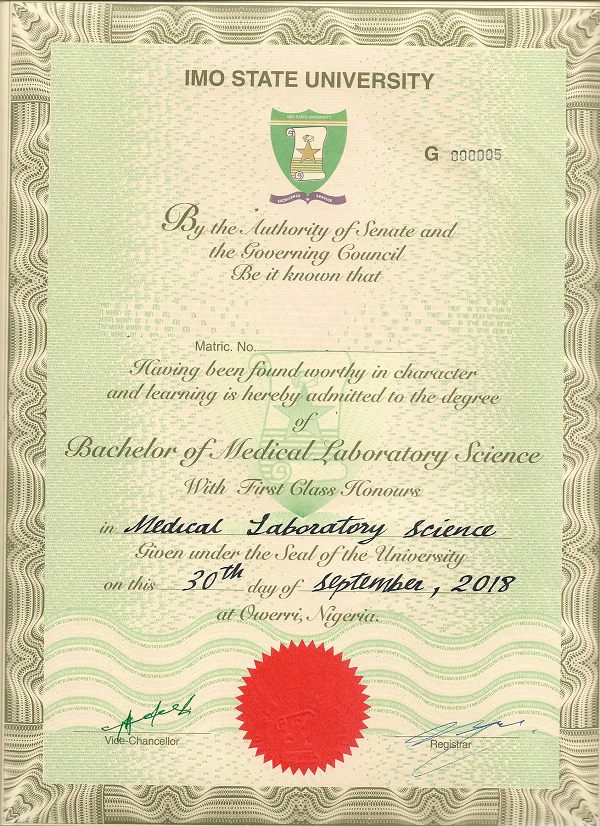Medical Laboratory Science
Determination of the effect of malaria on haematological parameters in pregnancy; A study of Federal Medical Center (FMC) Owerri
Determination of the effect of malaria on haematological parameters in pregnancy; A study of Federal Medical Center (FMC) Owerri
ABSTRACT
The study is on “Determination of the effect of malaria on haematological parameters in pregnancy; A study of Federal Medical Center (FMC) Owerri”. The study has four objectives. A total of 40 pregnant women were randomly selected, twenty apparently healthy pregnant women with malaria as test group and twenty pregnant women without malaria as control; were used as subjects. Five millimetres of blood was collected by venepuncture using aseptic technique from each participant into two EDTA bottles 2.5ml for each EDTA container. One part was used for the determination of haematological parameters while the other was used for the diagnosis of malaria. Mean corpuscular volume (MCV), mean corpuscular haemoglobin concentration (MCHC), white blood cell (WBC) count, platelet count, haemoglobin level, packed cell volume (PCV) were determined using automated cell counter. The findings of the reveals that study shows a lower level of all the parameters in malaria infected pregnant women than the control (pregnant women without malaria). There were very significant difference in PCV, Hb, platelet, R.BC,and WBC; there was no significant difference in MCHC and MCH. The study therefore recommends that There should be a routine antenatal analysis of red culls and indices such as MCHC and MCV in pregnant women to term. There should be a 24/7 preventive measure for pregnant women not to be infected with malaria.
CHAPTER ONE
INTRODUCTION
Pregnancy is defined as the fertilization or development of one or more offsprings known as an embryo or foetus in a woman’s uterus. In pregnancy, there could be multiple gestations in the case of twins or triplets. Childbirth usually occurs about 38 weeks after conception or 40 weeks from the start of the last normal menstrual period to parturition (Bulte, 2000). An embryo is the developing of offspring during the first eight weeks after conception after which the term foetus is used until birth (Jayson, 2011).
Pregnancy can be of different types namely; intrauterine, ectopic, thank, singlet, intra-abdominal, multiple or lupus pregnancy.
Pregnancy can occur by sexual intercourse or assisted reproductive technology.
During pregnancy, mothers encounter some physiological changes which are entirely normal. They include haematologic, metabolic, cardiovascular, renal and respiratory changes. Increase in blood sugar, breathing and cardiac output are all required. Levels of progesterone and oestrogen rise continuously throughout pregnancy suppressing the hypothalamic axis and subsequently the menstrual cycle (Campbell et al., 2001).
Malaria in pregnancy is a major public health problem, especially sub Saharan Africa. The burden of malaria in pregnancy is caused chiefly by Plasmodium falciparum, the most common of the Plasmodium species, especially in sub Saharan Africa (Waldie, 2002). Pregnant women are more susceptible than the generalpopulation to malaria. They are more likely to become infected, have a reoccurrence, develop severe complications and might due from the disease. Malaria in pregnancy caused by Plasmodium falciparum, Plasmodium Vivax, Plasmodium ovale and Plasmodium malariae. Regardless of symptoms, the presence of plasmodial parasites in pregnant woman’s body will have a negative impact on her own health and that of her foetus. Malaria is likely to occur during second and third trimester. Plasmodium species infection during pregnancy increases the channels of maternal anaemia, abortion, stillbirth, prematurely intrauterine growth retardation and infant low birth weight which is the greatest single risk factor for death in the first month of life.
Malaria infection during pregnancy contributes significantly to anaemia in pregnancy and low birth weight babies (Deen et al., 2009). The presence of parasites in peripheral blood without symptoms is common in hyper endemic areas and is associated with chronic anaemia and placental sequestration (Nwagha et al., 2009). Malaria has been estimated to cause 80% to 14% of all low birth weight babies and 3% to 8% of all infant deaths in areas of Africa with stable malaria transmission. In terms of its effects on mothers, severe anaemia increases. The risk for maternal mortality and malaria anaemia is estimated to cause as many as 10,000 maternal deaths each year in Africa.
The impact of the other three human malaria parasites (Plasmodium vivax, Plasmodium malariae and Plasmodiumovale) is less clear.The promising news is that during the past decade, potentially more effective strategies for control of malaria in pregnancy have been developed and demonstrated to have remarkable or improving the health of mothers and their newborn.
Malaria in pregnancy has increased morbidity and mortality rate annually from direct and indirect causes of malaria.
Pregnant mothers experience severe anaemia, miscarriages, stillbirth, low birth weight babies and death. Also, psychological traumas in families and significant other cannot be disqualified. Pregnancy places extreme stress on the haematological system and understanding of the physiological changes that result in obligatory in order to interpret any need for therapeutic intervention.
Physiological anaemia is the often used to describe the fall of haemoglobin (Hb) concentration that occurs during normal pregnancy. Blood plasma volume increases by approximately 1250ml of 45% above normal by the end of gestation and although the red cell mass itself increases by some 25%, this still leads to a fall in haemoglobin concentration. The white blood cell count also increases a d may peak at over 30mg/ml under stressful condition (A. V et al., )
1.1. JUSTIFICATION
Malaria in pregnancy is different from the disease in non pregnant state. The rate of mosquito bite and the rate at which pregnant women are becoming anaemic is becoming alarming (BonyouAkotet et al., 2003), so there is need to investigate if malaria parasitaemia is one of the factors affecting haematological profile in pregnancy. The severity of malaria in pregnancy is thought to be due to general impaired immunity plus a climination of acquired immunity to malaria in endemic areas. This project is therefore carried out to determine if any haematological abnormality associated with malaria infected pregnant women.
1.2. AIM
- To determine the effect of malaria on haematological parameters in pregnancy.
1.3. OBJECTIVES
- To determine the PCV, Hb, WBC, MCV, MCH, MCHC, platelets in malaria infected pregnant women at different trimesters.
- To determinethe haematological parameters in pregnant women not infected with malaria.
- To compare the haematological parameters of malaria infected pregnant women with that of normal pregnant women.
- To compare the haematological parameters of malaria infected pregnant women at different trimesters.
Pages: 56
Category: Project
Format: Word & PDF
Chapters: 1-5
Material contains Table of Content, Abstract and References.
-

 IMSU News4 years ago
IMSU News4 years agoIs It Worth Registering a Pre-degree Program In IMSU? All you need to know about IMSU Pre-degree
-

 IMSU News5 years ago
IMSU News5 years ago7 Popular department in Imo State University (IMSU)
-

 IMSU News2 years ago
IMSU News2 years agoIMSU reprinting for 2023/2024 post UTME candidates has commenced
-

 IMSU News4 years ago
IMSU News4 years agoSteps on How to Apply for Certificate in Imo State University, Owerri (IMSU)

